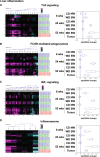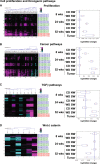The Transcriptomic Signature Of Disease Development And Progression Of Nonalcoholic Fatty Liver Disease
- PMID: 29222421
- PMCID: PMC5722878
- DOI: 10.1038/s41598-017-17370-6
The Transcriptomic Signature Of Disease Development And Progression Of Nonalcoholic Fatty Liver Disease
Erratum in
-
Author Correction: The Transcriptomic Signature Of Disease Development And Progression Of Nonalcoholic Fatty Liver Disease.Sci Rep. 2020 May 15;10(1):8374. doi: 10.1038/s41598-020-65506-y. Sci Rep. 2020. PMID: 32409700 Free PMC article.
Abstract
A longitudinal molecular model of the development and progression of nonalcoholic fatty liver disease (NAFLD) over time is lacking. We have recently validated a high fat/sugar water-induced animal (an isogenic strain of C57BL/6 J:129S1/SvImJ mice) model of NAFLD that closely mimics most aspects of human disease. The hepatic transcriptome of such mice with fatty liver (8 weeks), steatohepatitis with early fibrosis (16-24 weeks) and advanced fibrosis (52 weeks) after initiation of the diet was evaluated and compared to mice on chow diet. Fatty liver development was associated with transcriptional activation of lipogenesis, FXR-RXR, PPAR-α mediated lipid oxidation and oxidative stress pathways. With progression to steatohepatitis, metabolic pathway activation persisted with additional activation of IL-1/inhibition of RXR, granulocyte diapedesis/adhesion, Fc macrophage activation, prothrombin activation and hepatic stellate cell activation. Progression to advanced fibrosis was associated with dampening of metabolic, oxidative stress and cell stress related pathway activation but with further Fc macrophage activation, cell death and turnover and activation of cancer-related networks. The molecular progression of NAFLD involves a metabolic perturbation which triggers subsequent cell stress and inflammation driving cell death and turnover. Over time, inflammation and fibrogenic pathways become dominant while in advanced disease an inflammatory-oncogenic profile dominates.
Conflict of interest statement
Dr. Sanyal is the founder of the company Sanyal Biotechnology that performs pre-clinical drug-testing using the DIAMOND model.
Figures







References
Publication types
MeSH terms
Grants and funding
LinkOut - more resources
Full Text Sources
Other Literature Sources
Medical
Molecular Biology Databases

